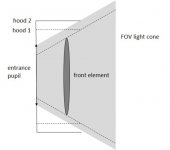OlivierAOP
medium format
I thought I'd share some simple formulas to make custom lens hoods. If you have a 3D printer and are familiar with CAD modeling they are relatively easy to make.
To be truly effective in reducing the amount of non-image-forming light from reaching the lens, they need to be tuned to a specific f-no value, and one must locate the entrance pupil of the lens, from which the lens hood length is measured.
In other words, if designed at a given f-no N, the hood obtained using the calculation below will vignette at lower N values and won't be as effective at larger N values. But they would still look cool and protect the lens somewhat.
So, for a given sensor height s, a focal length f, f-no N and hood length L (from the entrance pupil), the hood should have height
H = f/N + L*s/f,
and should have rounded corners with diameter f/N (the entrance pupil size).
This way the hood is just short of vignetting the frame, allows but gradually vignettes a range of light rays outside the FOV, and completely blocks the remainder. This results in minimising the image around the sensor/film, although rear lens or sensor baffles also help in that regard. The length v of the vignetted image next to the sensor edge is
v = f*f/L/N.
So the longer the hood, the more effective it is for a given lens.
For a round hood, s is the diagonal of the sensor. But rectangular hoods are more effective than round hoods.
To be truly effective in reducing the amount of non-image-forming light from reaching the lens, they need to be tuned to a specific f-no value, and one must locate the entrance pupil of the lens, from which the lens hood length is measured.
In other words, if designed at a given f-no N, the hood obtained using the calculation below will vignette at lower N values and won't be as effective at larger N values. But they would still look cool and protect the lens somewhat.
So, for a given sensor height s, a focal length f, f-no N and hood length L (from the entrance pupil), the hood should have height
H = f/N + L*s/f,
and should have rounded corners with diameter f/N (the entrance pupil size).
This way the hood is just short of vignetting the frame, allows but gradually vignettes a range of light rays outside the FOV, and completely blocks the remainder. This results in minimising the image around the sensor/film, although rear lens or sensor baffles also help in that regard. The length v of the vignetted image next to the sensor edge is
v = f*f/L/N.
So the longer the hood, the more effective it is for a given lens.
For a round hood, s is the diagonal of the sensor. But rectangular hoods are more effective than round hoods.


